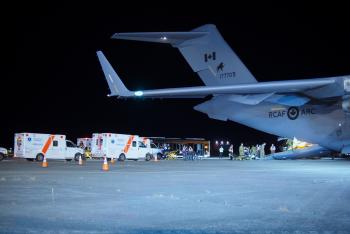Image Caption
Summary
Local Journalism Initiative Reporter
Windspeaker.com
Beverly Lightfoot, Indigenous Health Liaison Team coordinator for the Fraser Health Authority, knows her 11-member team played a valuable role with Indigenous patients who were evacuated from Stanton Hospital in Yellowknife as wildfires threatened the Northwest Territories’ capital city.
“For Indigenous peoples…the trauma, which is accompanied by being uprooted from their home, from their land, that could create stress. So I think just having us there helped,” said Lightfoot, who is Cree from Moosomin First Nation in Saskatchewan.
Lightfoot and her team were included in the planning when, on Aug. 15, a Royal Canadian Air Force C-17 Globemaster aircraft landed in Vancouver with 55 hospital patients and long-term care residents.
The evacuation marked the first time Fraser Health’s Indigenous Health Liaison Team was activated to support patients on such a large scale.
“I was very happy and pleased that the Indigenous Health Liaison Team was invited to participate in the transportation of these individuals,” said Lightfoot.
She is also a nurse and was accompanied by two other members of her team, also nurses, to meet the plane on the tarmac. They provided the eight patients, who identified as Indigenous, with a culturally safe welcome.
They were able to assess the patients, as well as manage medication for those who required it. They sat with the patients as they waited for transport to facilities within Fraser Health. They provided the patients with food and drink, helped them use the bathroom and offered companionship.
“Just knowing that we're there, I think, they were grateful for and knowing that…we'll continue to follow them on their healthcare journey while they're with us in Fraser Health,” said Lightfoot. That gratitude also extended to family members who were unable to accompany the patients but were contacted by the liaisons about their loved ones.
Most N.W.T. evacuees were settled in Alberta.
The eight Indigenous patients were placed in six different facilities within Fraser Health. Placement, says Lightfoot, based both on the level of care needed as well as spaces available.
While having the patients spread throughout the region could have been a challenge, Lightfoot takes pride in the way her team “came together in just such a beautiful way.”
Although they don’t work on weekends, they offered to put in the overtime hours which allowed the patients to be placed on the “high priority list.” They were followed up on the very same day.
The patients received medicine bundles, which are put together in ceremony by the Indigenous liaisons, as well as other cultural supports.
“Everybody is different, an individual with their needs and supports. The liaisons are all…spectacular at their job, so they're able to do an assessment on needs and go forward with whatever they may need to do for that individual,” said Lightfoot, who points out that on Wednesday, an Elder provided a patient with an eagle fan brushing.
Four patients remain in Fraser Health. Two patients have been transferred back to N.W.T. and two others have been transferred to Calgary.
Lightfoot says that liaisons coordinated the transfers and have been in communication with the out-of-province healthcare sites.
“I just was so grateful that we could assist in any way that we can,” said Lightfoot.
Local Journalism Initiative Reporters are supported by a financial contribution made by the Government of Canada.

